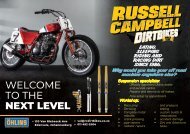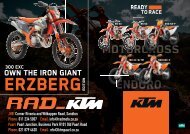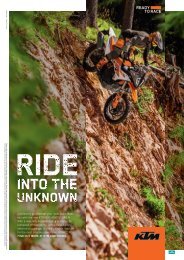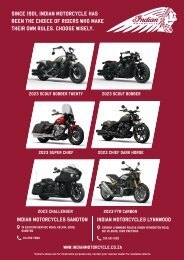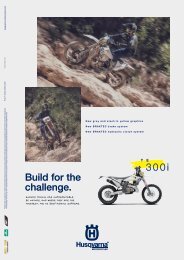DIRT and TRAIL January 22
You also want an ePaper? Increase the reach of your titles
YUMPU automatically turns print PDFs into web optimized ePapers that Google loves.
T<br />
South Africa<br />
to Slovenia part 5<br />
By Cronjé Bruwer<br />
A trip through<br />
Ethiopia...<br />
People keep asking me, which country on our trip was<br />
outst<strong>and</strong>ing to us? My honest <strong>and</strong> unequivocal answer is <strong>and</strong><br />
always will be Ethiopia!, the Simien mountains <strong>and</strong> history is<br />
outst<strong>and</strong>ing. The Simien Mountains, in northern Ethiopia, north<br />
east of Gondar in Amhara region, are part of the Ethiopian<br />
Highl<strong>and</strong>s. They are a World Heritage Site <strong>and</strong> include the<br />
Simien Mountains National Park. The mountains consist of<br />
plateaus separated by valleys <strong>and</strong> rising to pinnacles, Ras<br />
Dashen, also known as Ras Dejen, is the highest mountain<br />
in Ethiopia <strong>and</strong> fourteenth highest peak in Africa. Located in<br />
the Simien Mountains National Park in the Amhara Region, it<br />
reaches an elevation of 4,550 meters<br />
We entered Ethiopia at Moyale the border town. This town<br />
is a conflict point between tribes due to grazing fields, this<br />
border post is therefore closed from time to time. Chatting to<br />
the locals, we also learned that the camel trade in the area<br />
between Kenya <strong>and</strong> Ethiopia is a major contributing factor to<br />
the violence in the area <strong>and</strong> the tension could be felt in the<br />
town <strong>and</strong> as my mother would have said, “This is not the town<br />
she would like to retire in”.<br />
Once we crossed into Ethiopia petrol, or “benzene” as they<br />
refer to it, became scarce <strong>and</strong> the quality of fuel is of a low<br />
octane. We had to be careful to keep the revolutions of the<br />
motorcycles outside the “ping” zone. See photo 1 at a filling<br />
station, note the double tea strainers… which also gives you<br />
some idea on the fuel quality. Although locals queue for days,<br />
tourists always get to fill up first.<br />
Southern Ethiopia is not as spectacular as the northern part,<br />
but it is green with lush grazing fields, quite the opposite of<br />
northern Kenya, which is a desert.<br />
Photo 1<br />
The roads are all shared by trucks, cars, motorcycles,<br />
pedestrians, donkeys, goats, dogs <strong>and</strong> even chickens as<br />
seen in photo 2. Be very careful not to cause damage or<br />
harm to animals, as an exorbitant price will have to be paid<br />
as recompense for the animal, there is also very strict laws<br />
on vehicles causing harm to pedestrians. We took the road<br />
via Arba Minch <strong>and</strong> not the direct route to Addis Ababa, this<br />
was a very scenic route, “Arba Minch” means “40 Springs”<br />
the name was originated from the presence of more than 40<br />
springs, so you can really just imagine the natural beauty in the<br />
area. The guys were getting thirsty <strong>and</strong> stop at a “waterhole”<br />
was in order. We stayed over in Arba Minch on the shore of<br />
lake Abaya. Lake Abaya is a lake in the Southern Nations,<br />
Nationalities, <strong>and</strong> Peoples’ Region of Ethiopia. It is located in<br />
the Main Ethiopian Rift, east of the Guge Mountains. The town<br />
of Arba Minch lies on its southwestern shore, <strong>and</strong> the southern<br />
shores are part of the Nechisar National Park. Just to the south<br />
is Lake Chamo.<br />
The road from Awassa to Addis was under construction, which<br />
was challenging as there are no detour roads <strong>and</strong> you have to<br />
go between construction vehicles on whatever part of road is<br />
available. Sometimes you would find yourself in the oncoming<br />
lane but it really does not matter the Ethiopian driver are<br />
surprisingly courteous.<br />
The taxis in Ethiopia are something to experience, not only<br />
is the inside filled to capacity but approximately 4 to 5<br />
passengers sit on the roof. I unfortunately did not manage to<br />
get any photos of it but can be viewed on my YouTube videos.<br />
Photo 6 indicate how we prepare coffee along the road.<br />
Addis Ababa is a large <strong>and</strong> well organized city, traffic however<br />
is horrendous, see photo 7<br />
LIN









